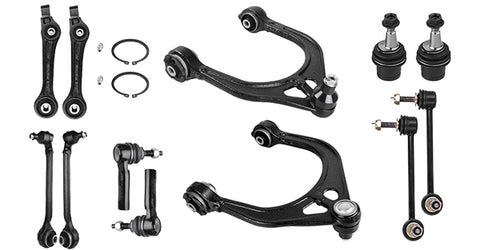As we all know, the suspension system is an important assembly of a modern car, which has a great influence on ride comfort and the car‘s handling stability. The control arm (also known as the swing arm) is used as the guide and force transmission element of the automobile suspension system and transmits various forces acting on the wheel to the body while ensuring that the wheel moves according to a certain trajectory. The car control arm elastically connects the wheels and the vehicle body through ball joints or bushes respectively. Therefore, the control arm (including the bushing and the ball joint connected thereto) should have sufficient rigidity, strength, and service life.
The role of car control arms

The car control arm is further divided into a front swing arm and a lower swing arm. The front swing arm is the guide and support of the suspension, and its function is to affect the positioning of the wheels and driving stability. The main function of the lower swing arm is to support the shock absorber of the body and buffer the vibration during driving. The reducer can play a good role in assisting the lower suspension arm, and its tacit cooperation with the shock absorber and spring can form an excellent suspension system (assembly).
1. How to replace an upper control arm?
An upper control arm also called the upper swing arm, is crucial for the car suspension. How to replace an upper control arm without spending a fortune? If the replacement is the same as the original size, it will not affect the car's performance. Pay attention to tightening according to the correct steps and torque in the maintenance manual during installation. After installation, do a four-wheel alignment to check the suspension data (within the qualified range). (Please click on the title to view more information about replacing the car's upper control arm.)
2. How to remove a lower control arm?
Two rubber bushings at the pivot point are used to transfer the car's weight through the control arm. They are bolted onto the frame by bolting them to the pivot point. These bushings can be affected by driving habits and road conditions. They will eventually wear out and become damaged. You can inspect these bushings by lifting the car and looking for irregularities in the rubber center. The ball joint is often built into car control arms. This joint will need to be replaced with the control arm. First, you need to know how to remove a lower control arm. (Please click on the title to view more information about removing the car's lower control arm.)
3. What happens when your lower control arm breaks?
The control arms connects the car frame and the front fixed wheels. It is an essential component of a motor vehicle suspension. The car will bob up and down when it hits a bump or a pothole. And car control arm allows the tires to move and is crucial for road safety. The control arms and bushings will eventually wear out for smooth engine operation. What happens when your lower control arm breaks? Is it safe to drive? (Please click on the title to view more information about the car's lower control arm.)
4. Do you need an alignment after replacing the car control arms?
When adding a lift kit or other modifications to your vehicle's suspension, remember that control arms can affect wheel travel, suspension durability, wheel alignment, and wheel travel. If the car control arm is bad, the steering wheel may start to pull left or right. This can make it challenging to go straight because you have to use more force to control the steering wheel. The car will need more force to maintain its straight course as the control arm worsens. If you're looking for suspension modifications that increase vehicle performance without compromising on quality, replacing control arms is a great place to start. Do you need an alignment after replacing the car control arms? (Please click on the title to view more information about aligning car control arms.)








